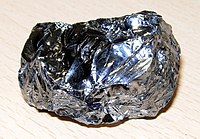
Photo from wikipedia
Abstract Recent experiments have shown that lithium isotopes can be significantly fractionated by diffusion in silicate liquids and in augite. Here we report new laboratory experiments that document similarly large… Click to show full abstract
Abstract Recent experiments have shown that lithium isotopes can be significantly fractionated by diffusion in silicate liquids and in augite. Here we report new laboratory experiments that document similarly large lithium isotopic fractionation by diffusion in olivine. Two types of experiments were used. A powder-source method where lithium from finely ground spodumene (LiAlSi2O6) diffused into oriented San Carlos olivine, and piston cylinder annealing experiments where Kunlun clinopyroxene (∼30 ppm lithium) and oriented San Carlos olivine (∼2 ppm lithium) were juxtaposed. The lithium concentration along traverses across the run products was measured using both laser ablation as a source for a Varian 820-MS quadrupole mass spectrometer and a CAMECA 1270 secondary ion mass spectrometer. The CAMECA 1270 was also used to measure the lithium isotopic fractionation across olivine grains recovered from the experiments. The lithium isotopes were found to be fractionationed by many tens of permil in the diffusion boundary layer at the grain edges as a result of 6Li diffusing significantly faster than 7Li. The lithium concentration and isotopic fractionation data across the olivine recovered from the different experiments were modeled using calculations in which lithium was assumed to be of two distinct types – one being fast diffusing interstitial lithium, the other much less mobile lithium on a metal site. The two-site diffusion model involves a large number of independent parameters and we found that different choices of the parameters can produce very comparable fits to the lithium concentration profiles and associated isotopic fractionation. Because of this nonuniqueness we are able to determine only a range for the relative diffusivity of 6Li compared to 7Li. When the mass dependence of lithium diffusion is parameterized as D 6 Li / D 7 Li = ( 7 / 6 ) β , the isotope fractionation for diffusion along the a and c crystallographic direction of olivine can be fit by β = 0.4 ± 0.1 while the fractionation in the b direction appears to be somewhat lower. Model calculations were also used to fit the lithium concentration and isotopic fractionation across a natural olivine grain from a peridotite xenolith from the Eastern North China Craton. The isotopic data were fit using β values (0.3–0.36) similar to that of the laboratory experiments. This, along with the fact that the isotopic fractionation is restricted to that part of the mineral with a gradient in lithium concentration, is strong evidence that the lithium zoning of this mineral grain is the result of lithium loss by diffusion and thus that it can be used, as illustrated, to constrain the cooling history.
Journal Title: Geochimica et Cosmochimica Acta
Year Published: 2017
Link to full text (if available)
Share on Social Media: Sign Up to like & get
recommendations!